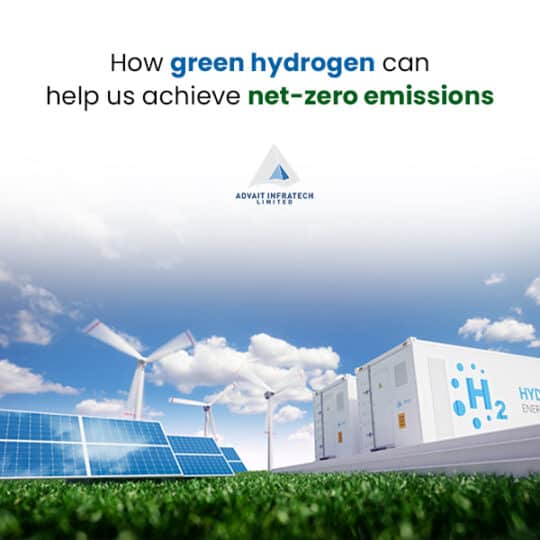-
en
- Contact
-
en
- Contact

The need for clean and sustainable energy sources has become paramount in our quest to combat climate change and achieve net-zero emissions. Green hydrogen, often touted as the fuel of the future, holds tremendous promise in this regard. This blog delves into the potential of green hydrogen as a key solution for decarbonizing various sectors and driving us towards a sustainable future.
Green hydrogen refers to hydrogen gas that is produced using renewable energy sources, such as wind, solar, or hydroelectric power, through a process called electrolysis. Unlike gray or blue hydrogen, which is derived from fossil fuels and emits carbon dioxide during production, green hydrogen is produced using clean energy and generates no harmful emissions.
The potential of hydrogen to aid in the decarbonization of industries, transportation, and energy has also recently attracted attention. When burned, the molecule only releases water vapour when utilised as a fuel in hydrogen fuel cells; otherwise, it does not release any CO2 emissions.
The National Green Hydrogen Mission states that hydrogen may be used for decentralized power generation, aviation, and marine transportation as well as for the long-term storage of renewable energy, the replacement of fossil fuels in industry, and sustainable transportation.
Green hydrogen is produced through various methods that utilize renewable energy sources to generate hydrogen gas. Each method offers a unique approach to producing green hydrogen, contributing to the development of a sustainable and carbon-neutral energy system. Thus, Green hydrogen can be produced through various methods, including:
Green hydrogen is essential to attaining net-zero emissions because it offers a clean, renewable energy source that replaces fossil fuels in various industries. Due to its adaptability, it may be used in a variety of sectors and energy systems, greatly lowering greenhouse gas emissions. Green hydrogen is a key component in our efforts to fight climate change and create a sustainable future since it offers many benefits.
First and foremost, green hydrogen is produced using renewable energy sources such as wind, solar, or hydroelectric power. Unlike gray or blue hydrogen, which are derived from fossil fuels, green hydrogen production generates no greenhouse gas emissions. This makes it a clean and environmentally friendly energy source, significantly reducing carbon dioxide and other harmful pollutants.
Another advantage of green hydrogen is its versatility. It can be used in a wide range of applications across various sectors, including transportation, power generation, and industrial processes. Green hydrogen offers a scalable and adaptable solution, whether it’s powering electric vehicles, generating electricity in fuel cells, or providing heat for industrial processes.
Moreover, green hydrogen plays a crucial role in achieving net-zero emissions. By replacing fossil fuels in different sectors with green hydrogen, we can significantly reduce our carbon footprint and work towards a sustainable energy system. Its ability to integrate with renewable energy sources further strengthens its potential in decarbonizing our energy infrastructure.
Green hydrogen applications encompass a wide array of sectors and industries, providing sustainable and clean solutions for energy needs. From transportation and power generation to industrial processes and energy storage, the versatility of green hydrogen makes it a promising tool in our transition towards a low-carbon and sustainable future.
The infrastructural cost of green hydrogen encompasses various aspects that need to be considered for its widespread adoption.
Companies are looking at hydrogen carriers because it holds potential as a renewable energy source. Because hydrogen carriers store energy more densely than pure hydrogen, more hydrogen can be delivered at once. Here are five key pointers regarding the infrastructural cost of green hydrogen:
Considering these factors, the infrastructural cost of green hydrogen is a significant consideration in its adoption, requiring substantial investments in production facilities, storage infrastructure, transportation and distribution networks, grid integration, and safety measures.
Green hydrogen holds immense potential in our journey towards achieving net-zero emissions. As a clean and versatile energy carrier, it offers a viable solution to address the challenges posed by decarbonization across various sectors.
The entire process is emissions-free by using renewable energy sources like wind, solar, or hydroelectric power to manufacture hydrogen through electrolysis. The generated green hydrogen may be transported, stored, and used as a dependable energy source in heating, power production, and transportation sectors.
Furthermore, green hydrogen provides a crucial pathway for decarbonizing sectors that are challenging to electrify directly, such as heavy industry and long-haul transportation. We can significantly reduce greenhouse gas emissions and mitigate climate change by substituting conventional fossil fuels with green hydrogen.
Green hydrogen represents a promising avenue widespread adoption that helps in transition to a sustainable, low-carbon future, while simultaneously addressing the pressing challenges of climate change and promoting economic prosperity.